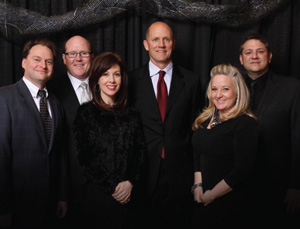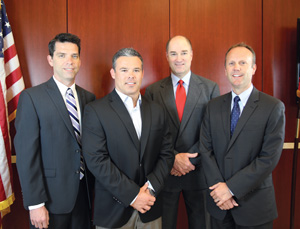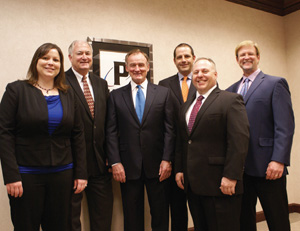
(l–r): Jim Janchar, Vice President of Finance; Scott Lokke, Vice President of Hospitality Operations; Shannon McKellar, Vice President of Marketing; Tom Cook, Senior Vice Presi- dent and General Manager; Julie Sola, Vice President of Gaming Operations; Samir Mowad, Vice President of Human Resources.
HARRAH’s NORTH KANSAS CITY
Come on, now: Is this really fair? Trying to assess the relative workplace merits of hundreds of eligible companies is tough enough. But with Harrah’s North Kansas City, it’s even tougher: After all, the 1,100 people employed there work in a casino. How many people come to your job site for their recreation?
But yes, it’s possible to take the glitz, the glitter, an atmosphere that can at times be electrically charged with customers who have high hopes or dashed hopes—and make an even better workplace out of it. How? Make sure your pay and benefits are competitive.
Harrah’s had to withstand the market impact of the metro area’s first major Kansas-side casino opening in 2012, and officials believe their compensation package is one reason why they lost only 19 people from the staff. And some of whom have already asked to come back to work in North Kansas City, even the ones who live near the Kansas facility in Village West. In addition to full- and part-time paychecks, there are full- and part-time benefit plans, providing coverage for medical, dental, life and vision insurance; there’s a 401(k) plan with a company match program, flexible-spending accounts and health-reimbursement accounts.
To address health-care costs, the company implemented Wellness Rewards programs that allow employees and their spouses to save up to $1,800 per year in health-insurance premiums—and it produced an astonishing 85 percent employee-participation rate. Tuition reimbursement covers 90 percent of the class costs for Harrah’s employees who meet academic guidelines. A rewards system called Total Service Credits, assigned for meeting quarterly customer-service goals, has allowed team members to buy airline tickets for trips to New York, new golf clubs or even assign the proceeds to help out with holiday shopping costs. Even in their first year on the job, employees can earn up to 18 days of paid time off—more than 3½ weeks. And here’s a perk you don’t see in many places: Team members can dine up to seven times for free every two weeks in the employee dining room.
The casino is backed by the organizational might of parent Caesars Entertainment, which has more than 70,000 employees nationwide. And with more than 50 casinos across the country, it offers ample opportunities for those who are hoping to make that corner of the hospitality sector a career.

(l–r): John Shaw, Senior HR Manager, Kiewit Power; Jason Hefley, Senior HR Manager, Kiewit Power; Mike Ross, President, Kiewit Power Engineers; Dave Flickinger, President, Kiewit Power.
KIEWIT POWER
Small, sexy start-ups inspire the entrepreneur in all of us, but successful, established and very big companies—with muscular compensation and benefits packages—have an appeal all their own. So it is with Kiewit Power. With more than 1,000 employees, this Lenexa subsidiary of Omaha-based Kiewit Corp. is part of a global family that numbers 11,500 staff and 18,500 craft employees. Muscular benefits? Kiewit matches employees’ 401(k) contributions up to 6 percent of their pay. That alone is an impressive match, one rarely seen in benefits programs. But each year since 2005, the company has contributed an extra 4 percent at the end of the year—a total contribution of 10 percent of annual base salary for plan participants. Sexy, indeed. To a compensation structure that targets the upper percentile of the market, the company adds a benefits package it believes is unmatched in the engineering sector: A high percentage of company’s share on the cost of health insurance premiums, company-paid short-term and long-term disability insurance, reimbursement for health and fitness activities, and wellness coaching. The raw might of $700 million in annual revenues allows Kiewit Power to make outlays that foster additional productivity, as with its $300 million campaign to upgrade its IT infrastructure. Tools like that, wedded to increased training and development opportunities, underwrite the company’s belief that its best chance of growth comes from providing its people with the means and desire to be successful. For many at the nexus of construction and energy production, recent years have been challenging. In response, Kiewit has pressed to keep its benefits package a step ahead of the industry overall, without letting cost-cutting imperatives detract from the comprehensive nature of the perks offered. One way to do that with a key cost driver—health insurance—is by offering deeply discounted premiums for employees who sign on for health-risk assessments and screenings. The company supports them with coaching and management programs to address risk and promote healthy living, and employees enjoy 100 percent-paid preventative care.

(l–r): Gloria Keating, CFO; Michael Gossman, Executive President; Smitty Belcher, CEO; Kollin Knox, Co-President– Construction Division; Phil Nehring, Executive Vice President; Bruce Belcher, Co-President–Construction Division. (not pictured): Michael Belcher, President–Service Division; Marvin Loecker, Executive Vice President.
P1 GROUP
Consolidating five separate engineering concerns into a unified corporate structure made all the sense in the world heading into 2007, but note the year. “We made this challenge a little bit more difficult on ourselves” by taking that step as the Great Recession dawned, CEO Smitty Belcher says. Positioning the company—now a comprehensive mechanical, electrical, refrigeration and plumbing contractor—for long-term success meant fully engaging the employees for the coming challenges. “The first thing we did was communicate,” Belcher says. “We organized the first annual all-office meeting” to articulate the vision for a consolidated company, and that led to a structure for keeping employees informed about significant achievements and bolstering morale. Then came P1 University, a multi-faceted in-house training program. “We made a commitment that even during a recession, we weren’t going to cut back on training,” Belcher says, and that “sent the message that our company was strong enough to continue to provide these types of opportunities even during an economic downturn.” As a final measure, P1 introduced Fundays, a monthly social gathering during the workday to bring people together, often over a meal or snack, he said. For more than 900 local employees, that positive mindset steered P1 Group through the lean times and a lame national recovery, and allowed executives to address other pressing issues. “Health insurance costs have been the largest challenge,” Belcher said. “We were fortunate enough to be able to go three years in a row without a premium increase.” As most other companies have found post-health-care reform, that trend couldn’t hold, but P1 has responded with an incentive plan to reward healthful activities, successful completion of which yields lower employee costs for premiums—a discount renewable each year. The company also changed to a plan with higher deductibles, but lower overall premiums and out-of-pocket expense maximums. It adopted a health savings account program, which allows funds to accumulate if unused, and to accrue interest. And a new retirement plan provides a wider range of investment options, Belcher said, with lower fees, increasing the earning power of P1 employees’ investments.